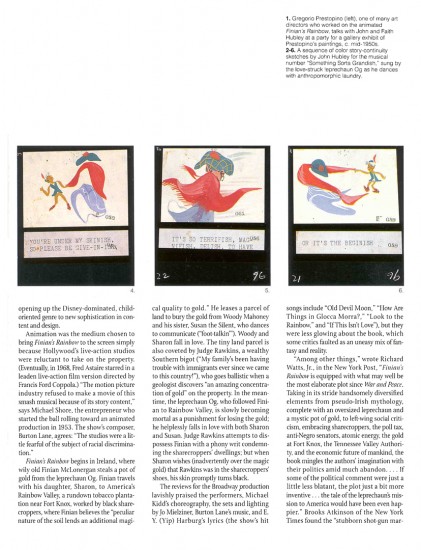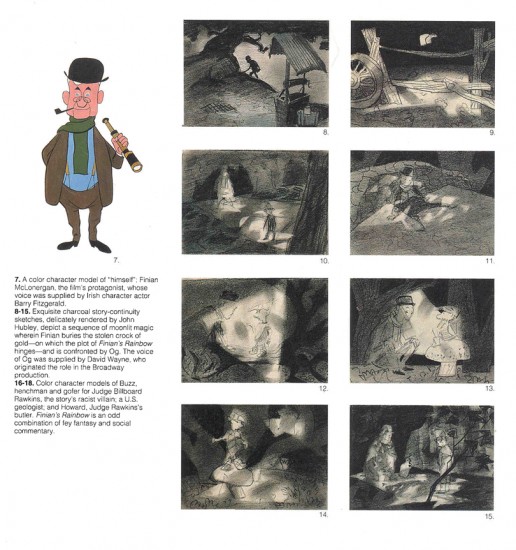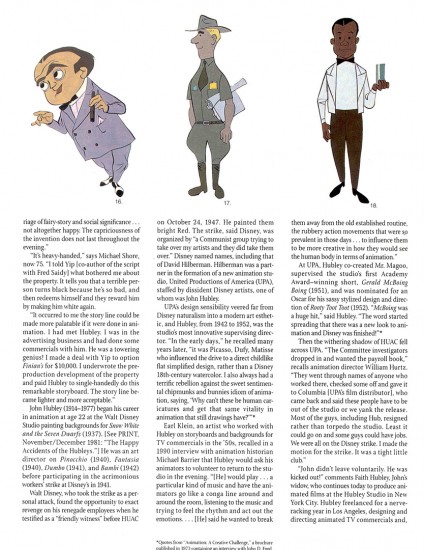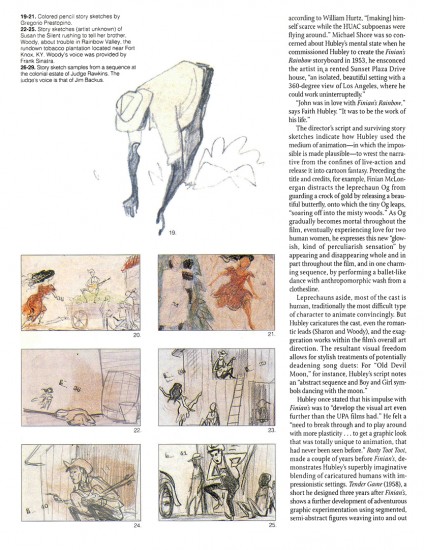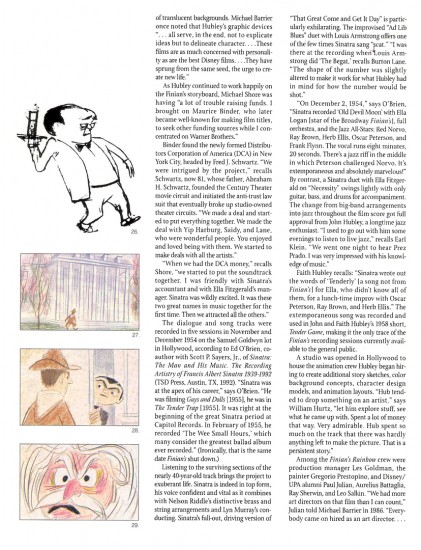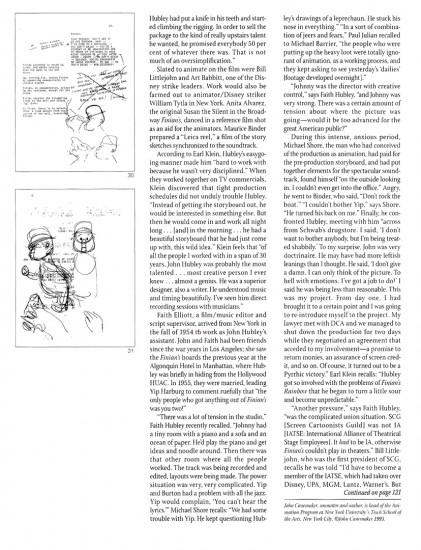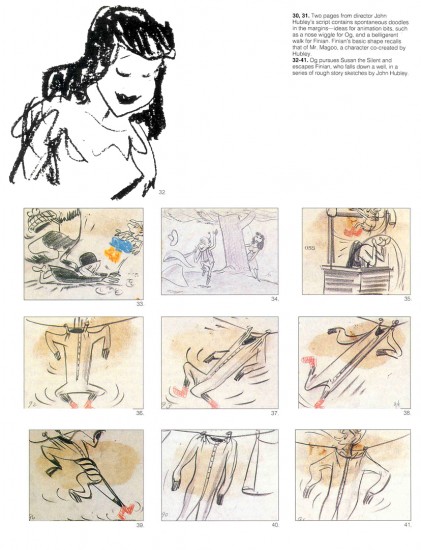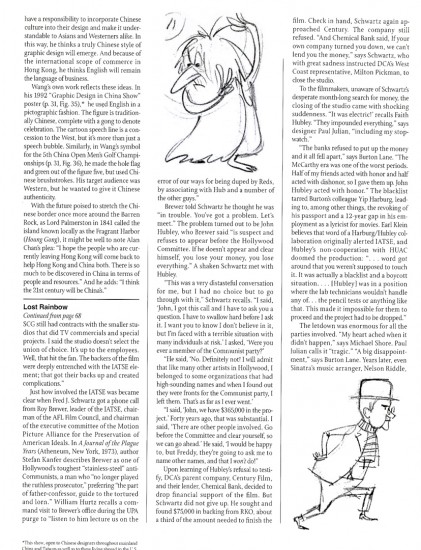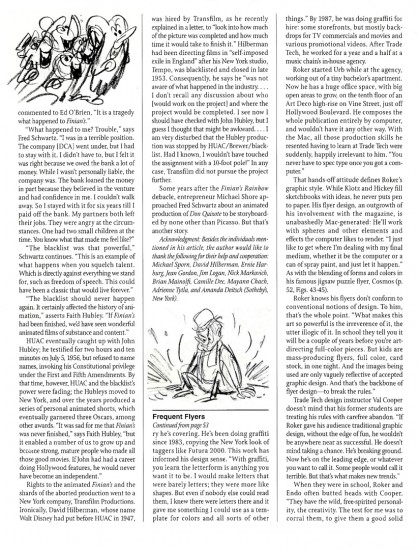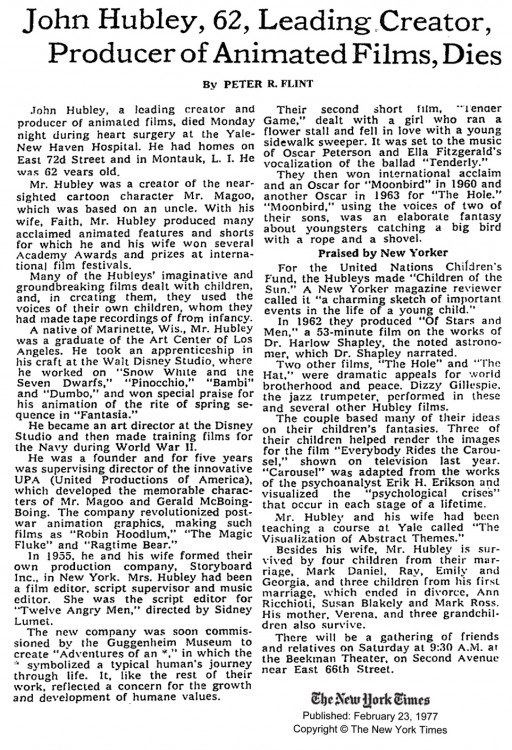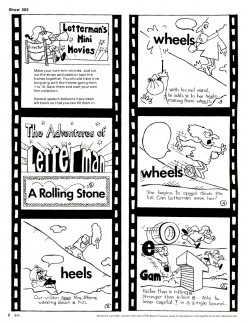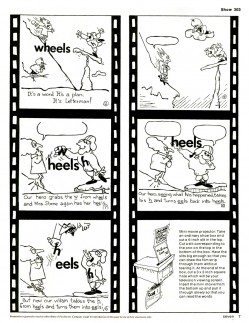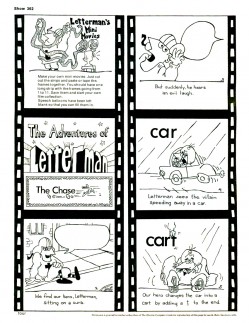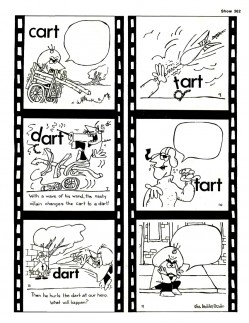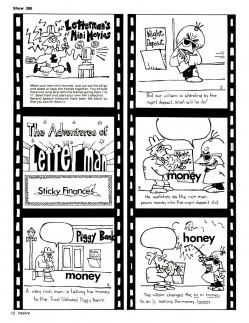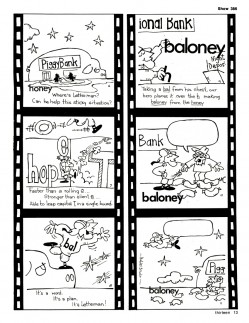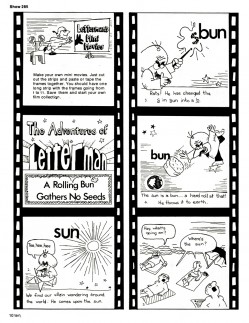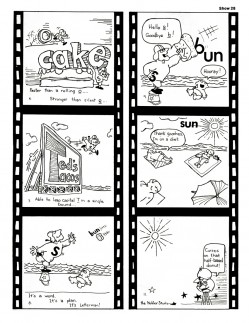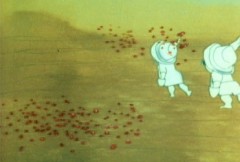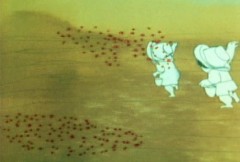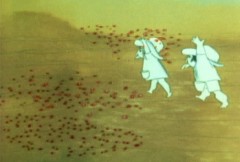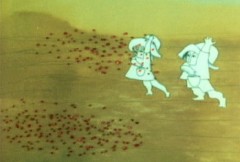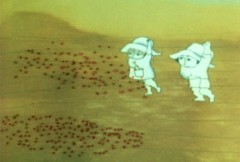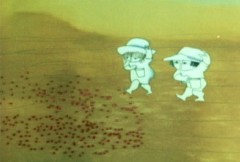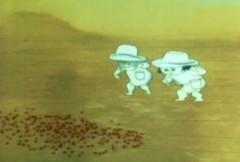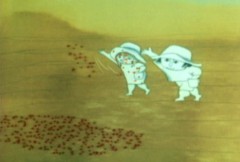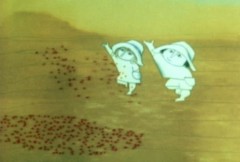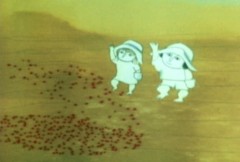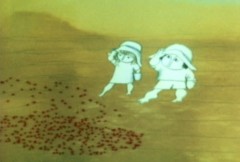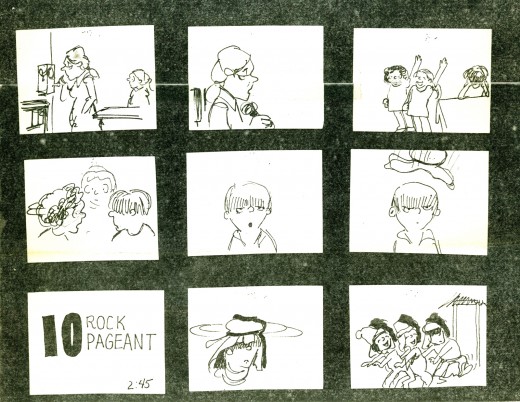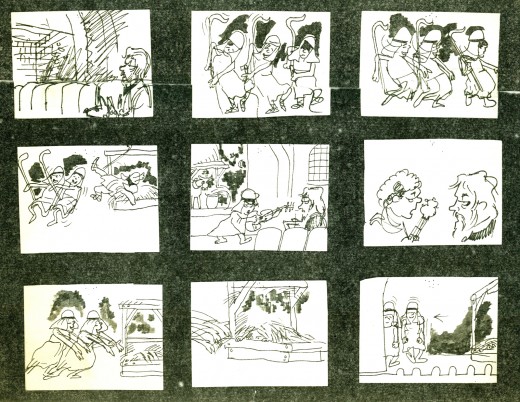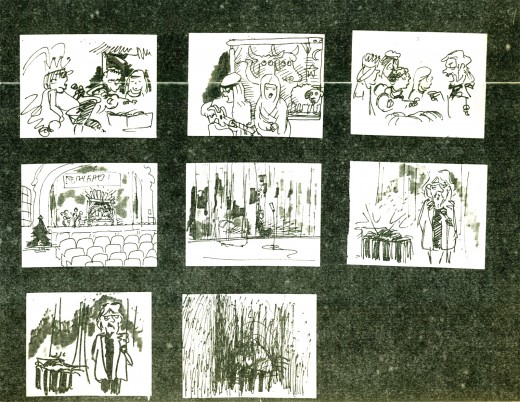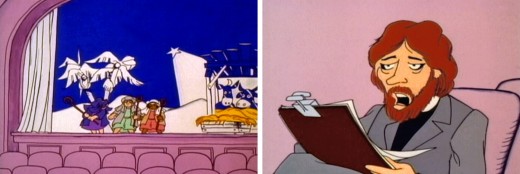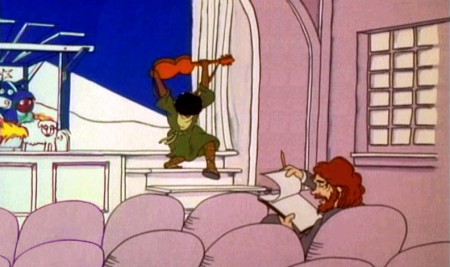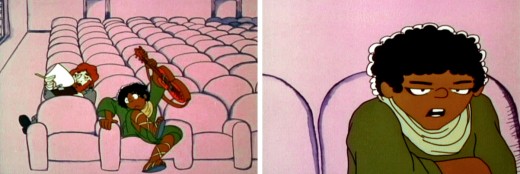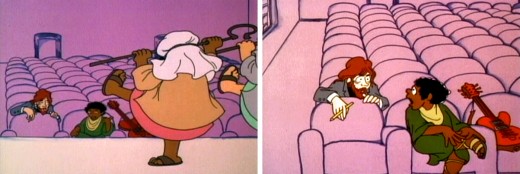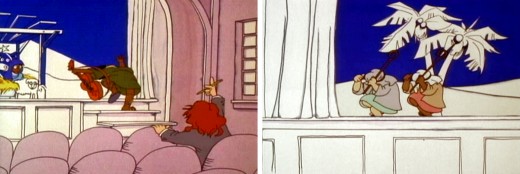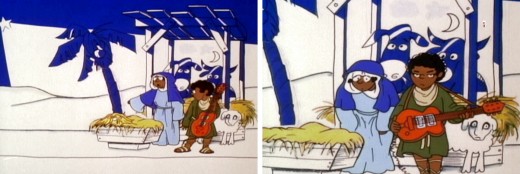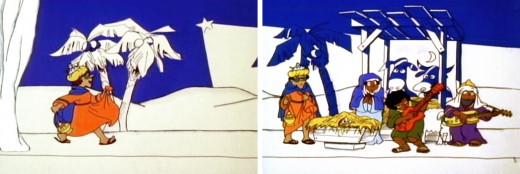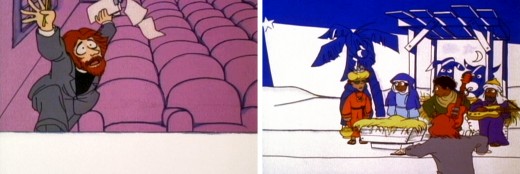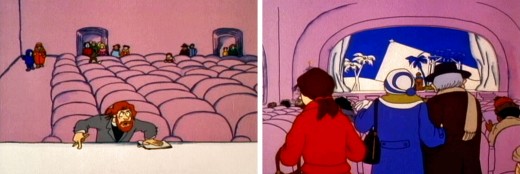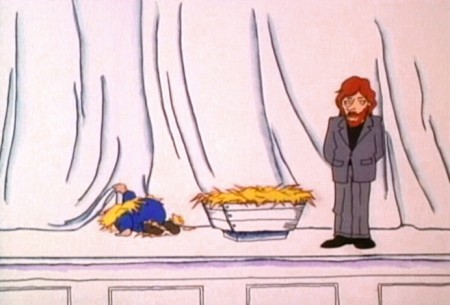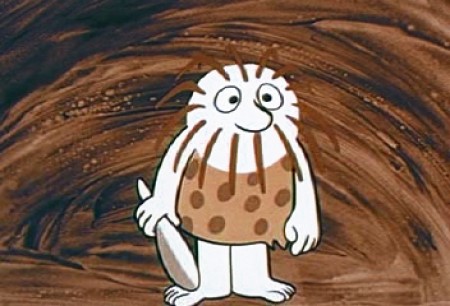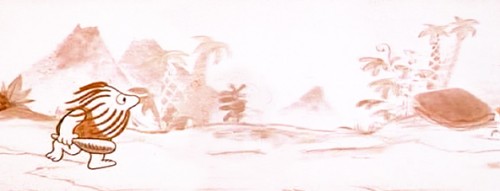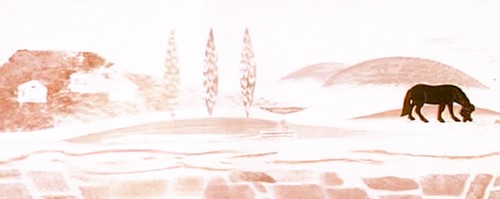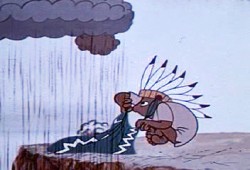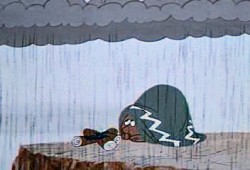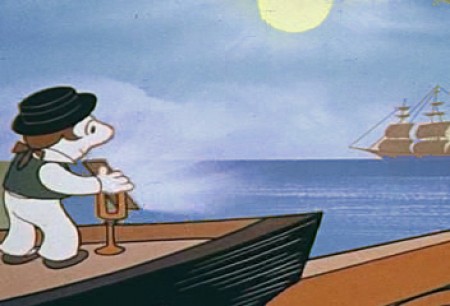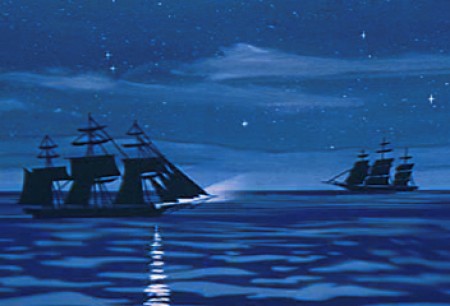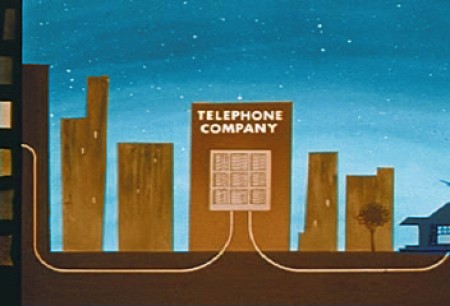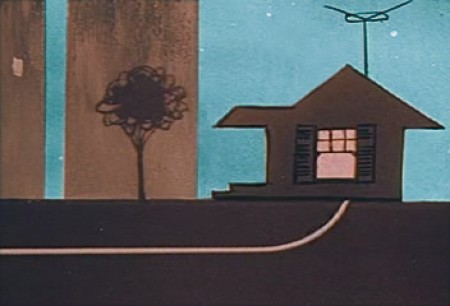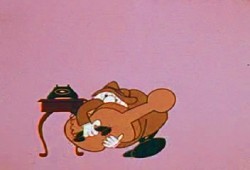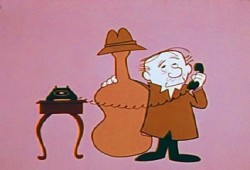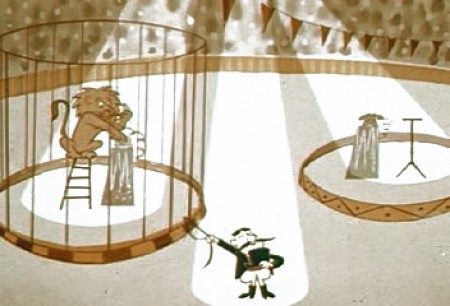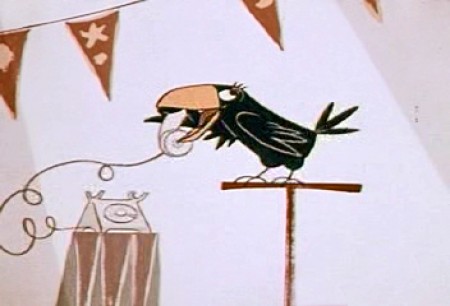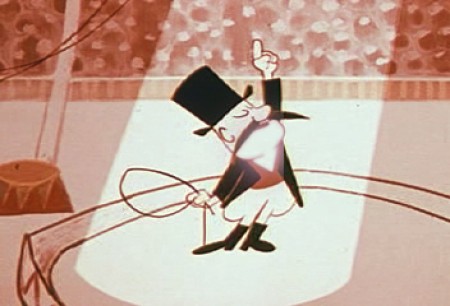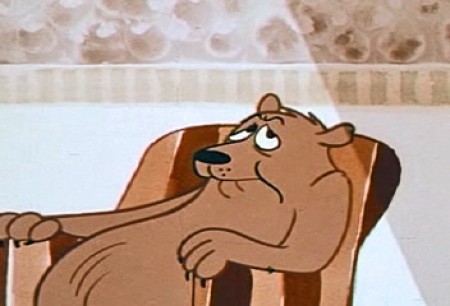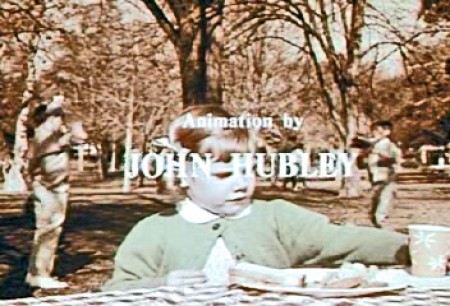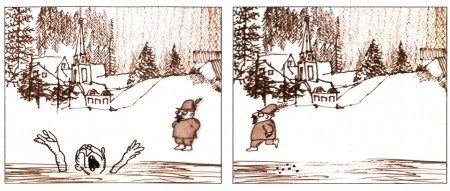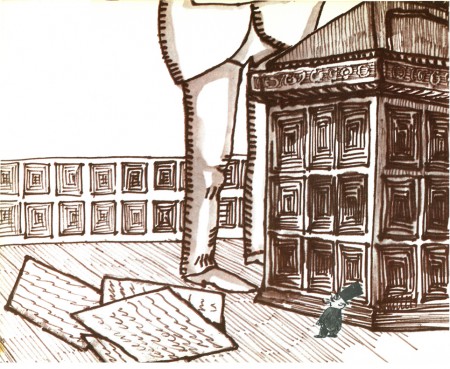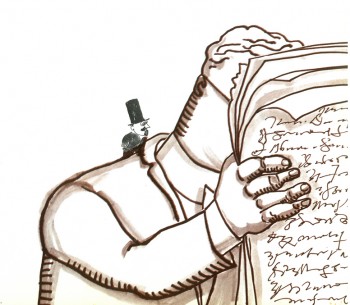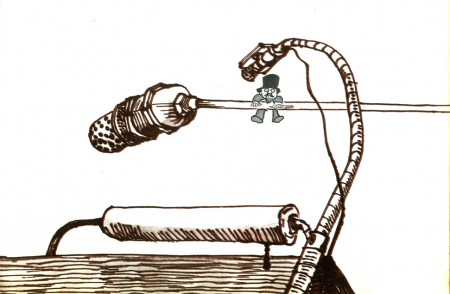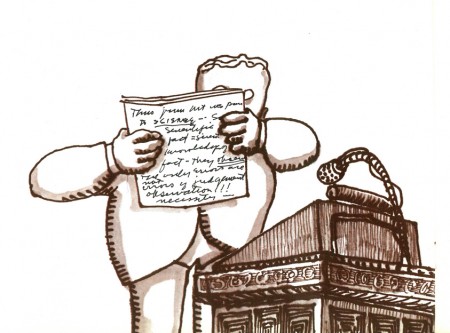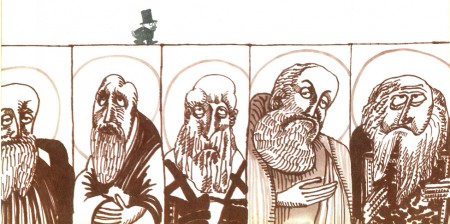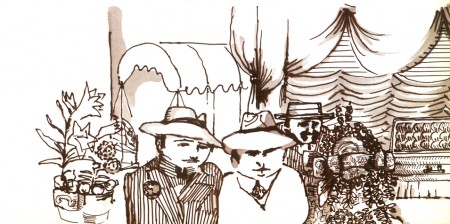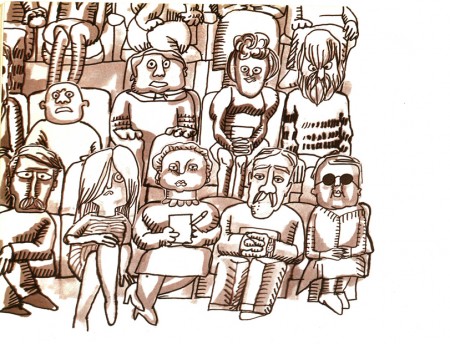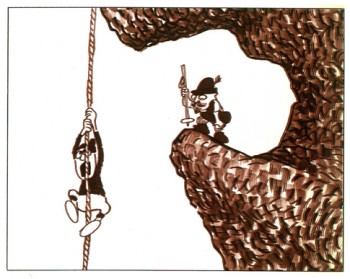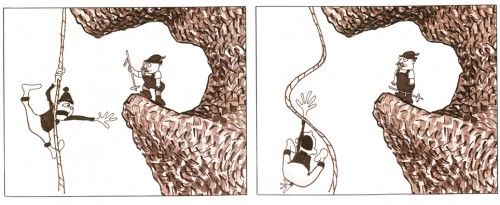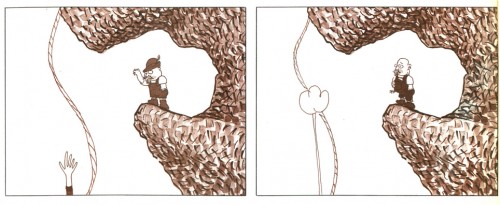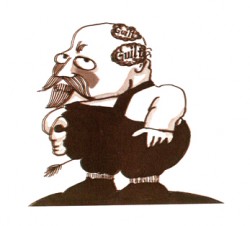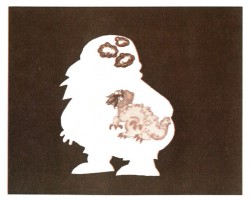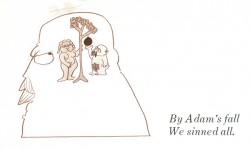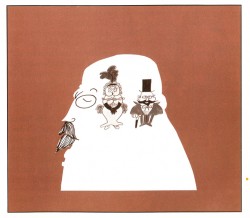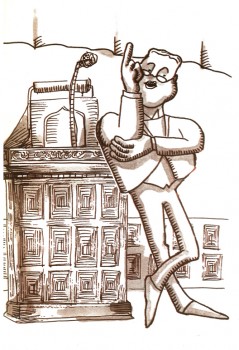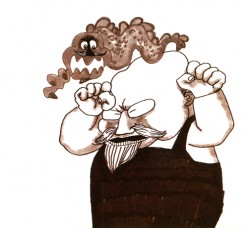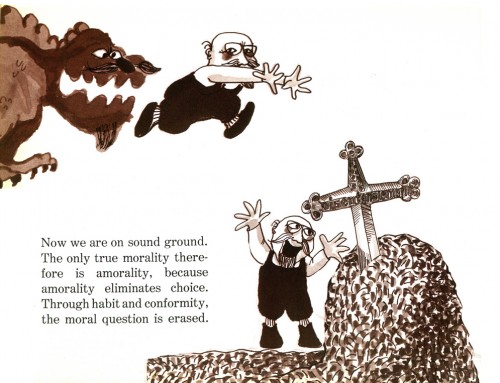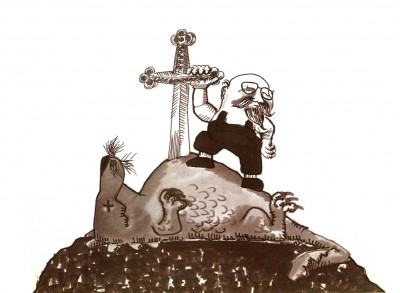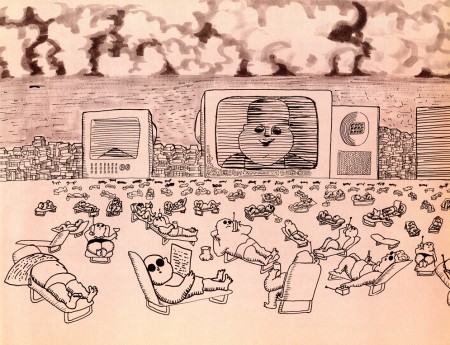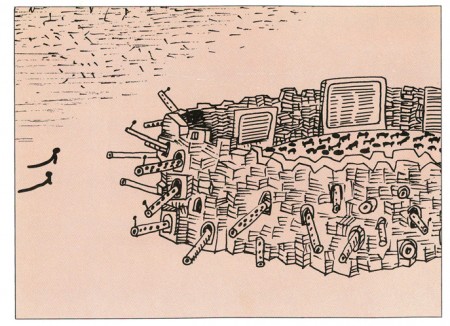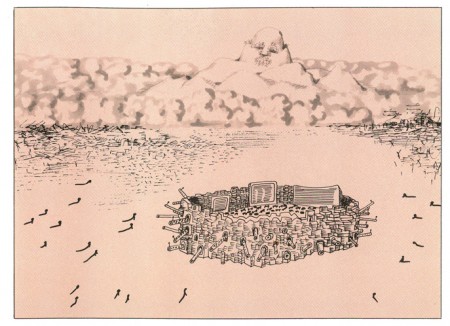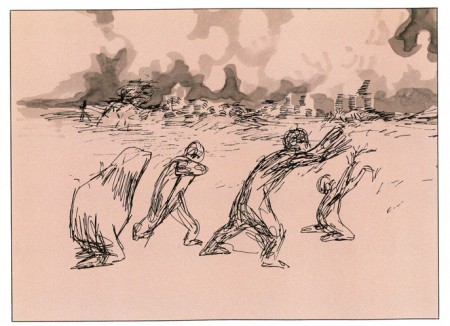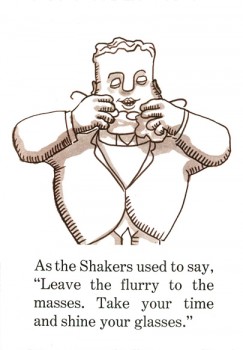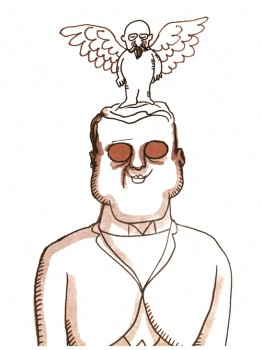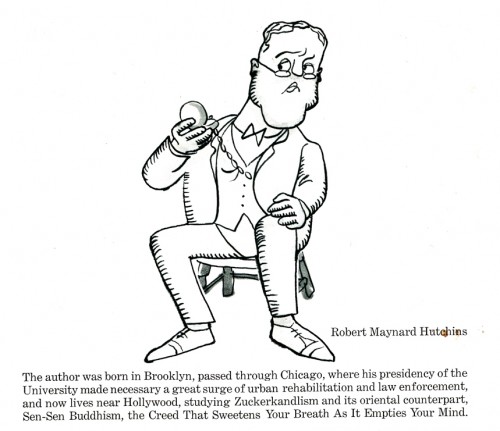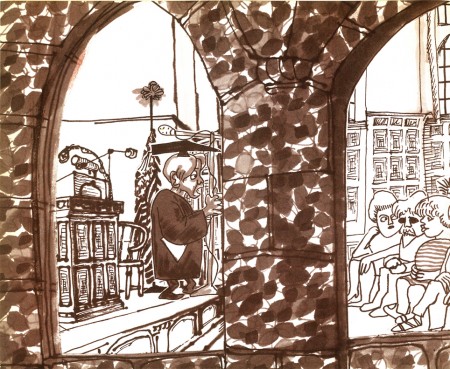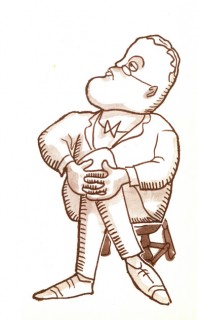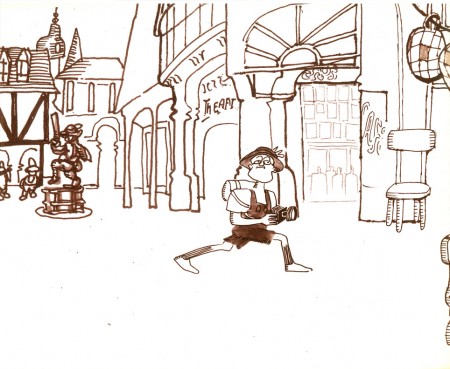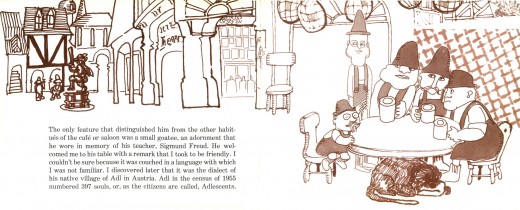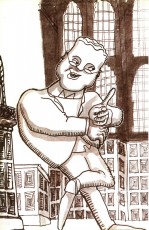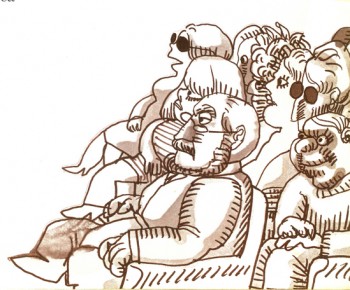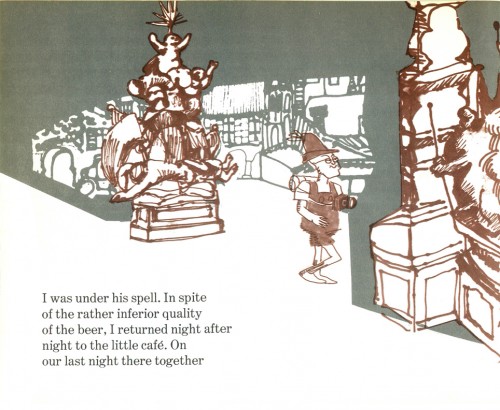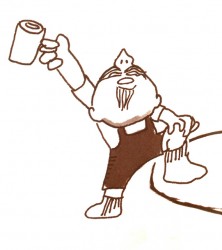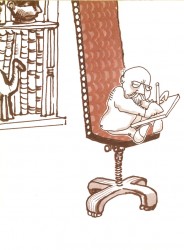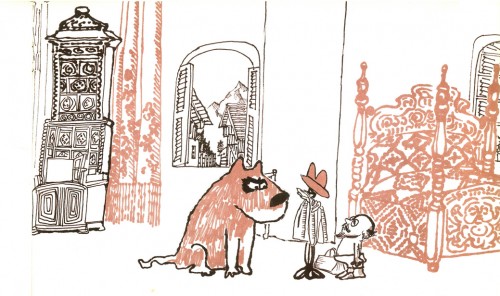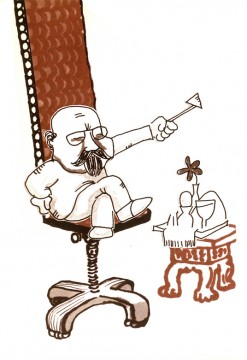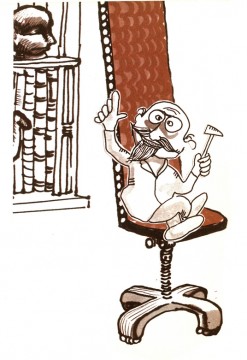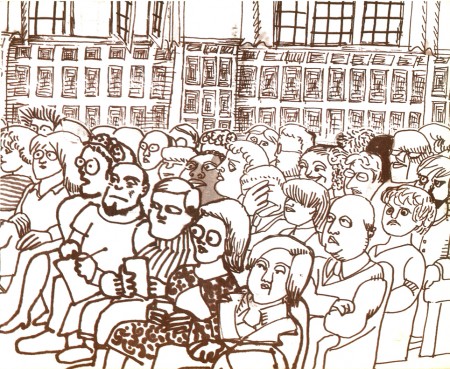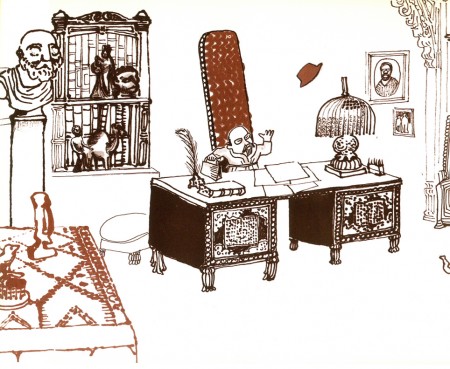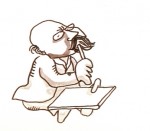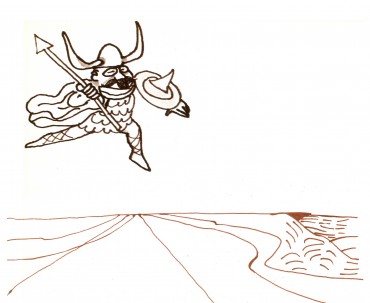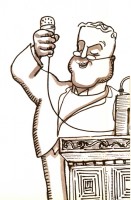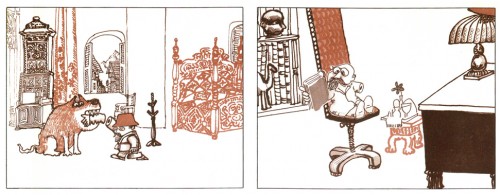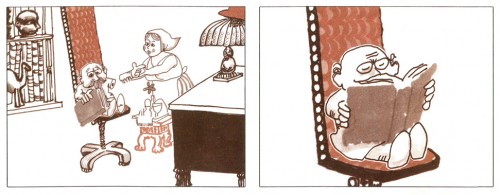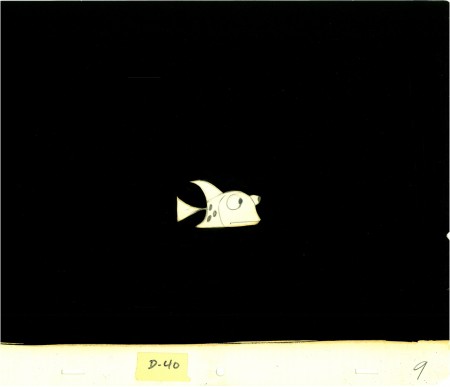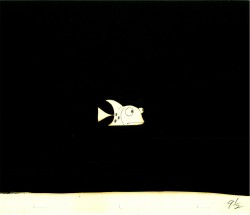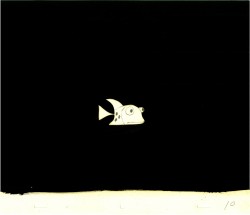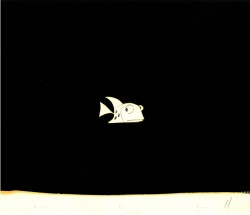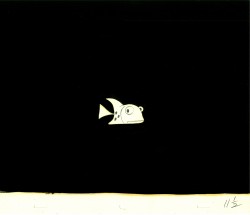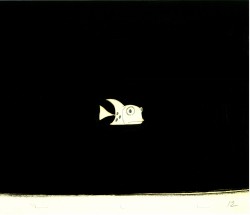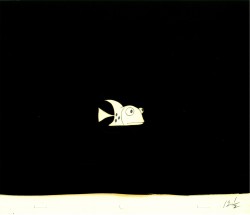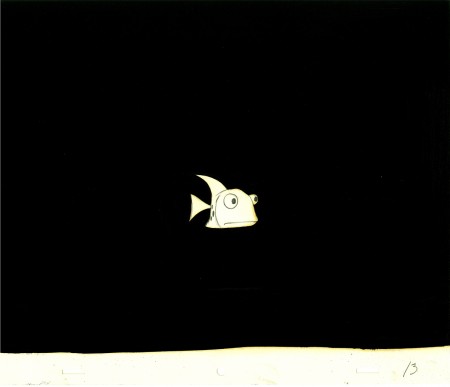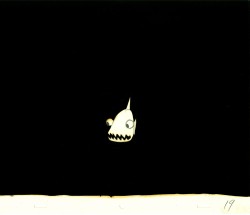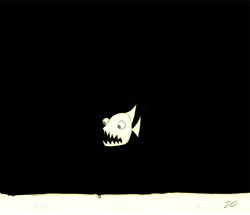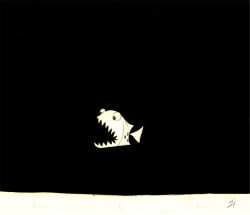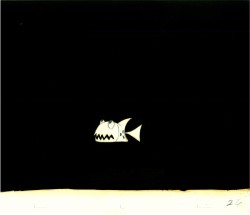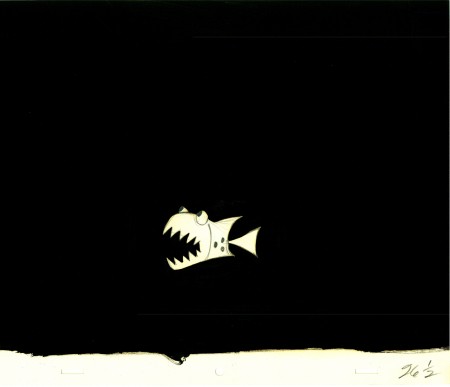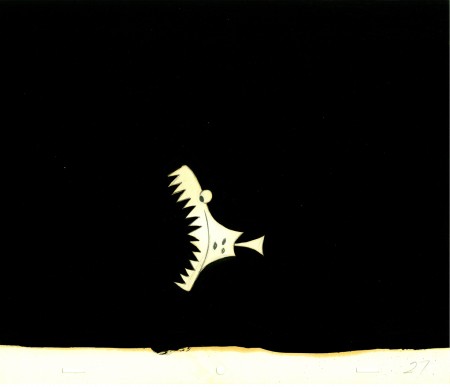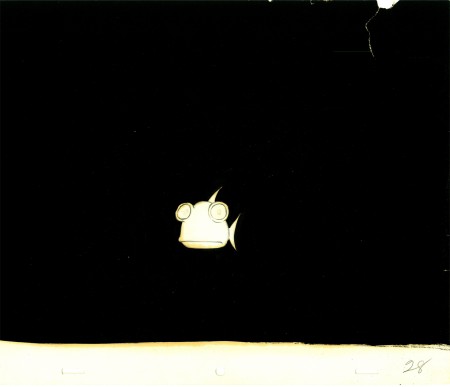Category ArchiveHubley
Articles on Animation &Hubley 24 Feb 2010 09:30 am
Finian’s Rainbow
I worried over how to exhibit this article. The PRINT pages were beautifully layed out, but they don’t offer the easiest, most legible design for the web. Hence, I’ve decided to post it twice. Today, I just post the original as jpegs. I’ll follow up by separating the images and posting them larger with web type. That’ll come tomorrow.
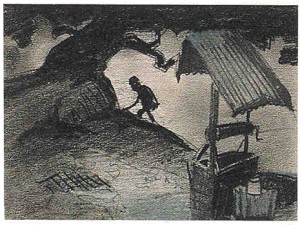 - A treasure of an article. John Canemaker wrote an article for the March/April 1993 edition of Print magazine an article about Finian’s Rainbow. This was an animated feature well under way in 1953 to be directed by John Hubley. It was to be an adaptation of the successful Broadway musical by Burton Lane and E.Y. Harburg. The film about racism twsted into a story fantasy story about love and leprachauns would have been the first official adult film done by a team of brilliant animation artists. The soundtrack would have featured songs sung by Frank SInatra, Ella Fitzgerald, Louis Armstrong, Oscar Peterson and Jim Backus.
- A treasure of an article. John Canemaker wrote an article for the March/April 1993 edition of Print magazine an article about Finian’s Rainbow. This was an animated feature well under way in 1953 to be directed by John Hubley. It was to be an adaptation of the successful Broadway musical by Burton Lane and E.Y. Harburg. The film about racism twsted into a story fantasy story about love and leprachauns would have been the first official adult film done by a team of brilliant animation artists. The soundtrack would have featured songs sung by Frank SInatra, Ella Fitzgerald, Louis Armstrong, Oscar Peterson and Jim Backus.
I remember hearing stories about animation in production at the Bill Tytla studio, with Tytla animating on it. In Hollywood, Art Babbitt and Bill Littlejohn were animating, with Paul Julian, Aurelius Battaglia and Gregorio Prestipino art directing. Maurice Binder had assembled a LEICA reel.
McCarthy and HUAC investigation brought the entire project down and set back the history of animation some 30 years.
John Canemaker’s given me permission to post this article and given this is the memorial of John Hubley’s death, I thought it appropriate to celebrate the artist.
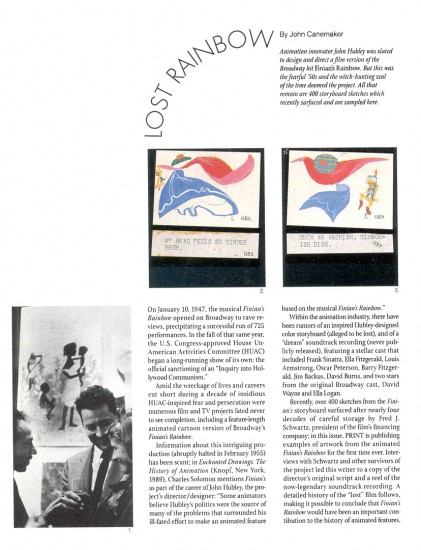 1
1
Articles on Animation &Hubley 23 Feb 2010 09:06 am
Anniversary
May 21 1914 – Feb 21 1977
.
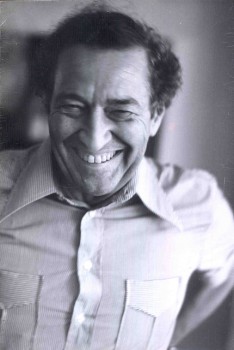
I couldn’t help myself but to post this obituary from the NYTimes when John had died. Sunday was the anniversary of his death, and I’ve returned to the source by way of UPA and the work he did there. Consequently, I decided to post this obit, and tomorrow I’ll have a more substantial article to post.
Animation Artifacts &Comic Art &Hubley 10 Feb 2010 09:20 am
Roll-A-Book Letterman
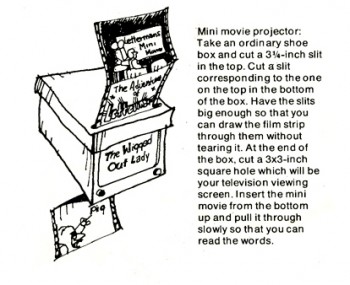 - The recent comments on Michael Barrier‘s post about the Dumbo Roll-a-book prompted Milt Gray to tell of his creating a homemade version of the device, which is well described in Barrier’s article.
- The recent comments on Michael Barrier‘s post about the Dumbo Roll-a-book prompted Milt Gray to tell of his creating a homemade version of the device, which is well described in Barrier’s article.
Of course, any kid of the ’50s knows this device well. I’d made them hundreds of times, and, in fact, found that by drawing the pictures I could make my own “films” for the homemade Roll-A-Book. Getting an opaque projector meant that these rolls of picture stories could be projected, and that’s just what we, my brothers and sisters, did daily. Every night one or more of us always had some kind of funny home-drawn cartoon story to project – one image at a time. And they went on for hours – large rolls of pictures.
When I went to work for the Hubleys, I became the Letterman guy. After working on a couple of seasons of Letterman animated cartoons, John got a gig to draw comic strips for The Electric Company Magazine. That meant I was doing the strips which were adapted from the shorts as they aired in the series.
I designed these strips as mini-movies advising kids to create home-theaters essentially Roll-A-Book devices. (See sample illustration above.)
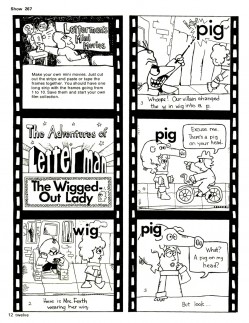 1
1 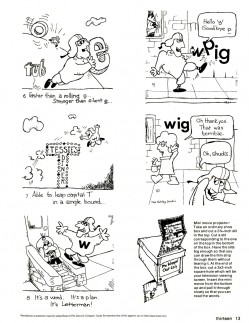 2
2(Click any image to enlarge.)
Articles on Animation &Hubley 23 Jan 2010 09:05 am
Up from Bugs
- It was definitely a more innocent time back then.
I found this article in the Aug. 5, 1961 issue of the New Yorker,
the Talk of the Town section:
The film officer of the United Nations Children’s Fund is a buoyant lady named Susan Burnett. Miss Burnett has given a little party at the U.N. to honor Mark and Hampy Hubley, the two very young narrators – Mark is eight and Hampy (short for Hampton) is four – of “Children of the Sun” an animated cartoon produced for UNICEF by the narrstors’ parents, John and Faith Hubley. We were among those present at the party, along with the Hubleys; absent, for reasons ranging from professional engagements elsewhere to afternoon naps, were several other contributors to the film’s sound track, including the narrators’ sister Emily, who is two; their sister Georgia, not yet one; the Budapest String Quartet; the violist Walter Trampler; and Pablo Casals.
The party began with a showing of the cartoon in the small basement screening room of the Secretariat Building. A charming sketch of important events in the life of a young child – spearing peas on a plate, climbing trees, daydreaming at the shore – it end with a quiet, harrowing comment to the effect that this happy child is fr from being typical of most of the children on earth, three-quarters of whom ar suffering from some degree of hunger. Except for a few concluding words recited in English by Mark Hubley (“For the first time in history, nations are united to rid the world of hunger . . . . The United Nations, through UNICEF, is dedicated to the children of the sun. The future of the earth depends on them.”), the sound track requires no dubbing for use in other countries, since the language it peas is either musical – excerpts from Bach’s Cello Suite No. 5, Haydn’s “Sunrise” Quartet, and Mozart’s Quintet in E Flat – or extraverbal, being the crowings and gurglings of various Hubleys, ingeniously synchronized with the action of the cartoon. Hampy identified the family sounds for us. “That’s Georgia,” he said during a bottle-feeding scene, and, during the pea-spearing one, “That’s Emily. She made those noises when we gav her a puzzle to play with.” The sounds of horseplay accompanying the seaside episode were made by Hampy, himself. “Me imitating a orchestra,” he said with pride. “I can do all the instruments, one at a time.”
When the movie was over, the party adjourned to the Delegates’ South Lounge, where refreshments appropriate to the assorted ages of the guests were served. Miss Burnett proposed a toast to the Hubleys, adding, for our benefit, that UNICEF is happier about “Children of the Sun” than about any other film it has put our. Miss Brunett discovered the Hubleys through their cartoon short “Moonbird,” which won an Academy Award two years ago. When she approached them, the were busy preparing their first feature-length cartoon – an adaptation of Harlow Shapley’s book “Of Stars and Men.” “What Miss Burnett told us about children starving all around the world was so shocking that we had to accept her assignment, which was to state the simple fact that children are hungry and to state it in such a way that it would be instantly comprehensible in any language or culture of locality or political circumstances,” Mr. Hubley said. “To keep matters both interesting and universal in a film is quite a job. Bug cartoons, which are what I started my career in, are easy, because a bug is so specific. Only a Paul Klee could make a bug that was interesting, generalized, and yet true to nature.”
Mr. Hubley a native of Wisconsin, was once an art director for Walt Disney, drawing not only bugs but such advanced cartoon images as the “Rite of Spring” sequence in “Fantasia.” After the war, in which he helped to make training films for the Army Air Forces, he had a hand in the famous UPA cartoon films, starring the Messrs. Magoo and McBoing-Boing. Five years ago, the Hubleys left Hollywood for New York and formed their own company here under the name of Storyboard, Inc. “We buy the groceries by making a few TV-commercial cartoons every year,” Hubley said. “The rest of the the time, we like to work on our own things, taking the attitude a painter would – making films that are a part of us and express something of us. A film is apt to cost us around twenty-five thousand dollars and, with luck, will pay for itself in ten years’ time.”
Sorry, I don’t have a copy of this film, and there are no stills of it on line so this goes without illustration.
Animation &Animation Artifacts &Hubley &Tissa David &walk cycle 23 Nov 2009 08:52 am
Tissa Seeding
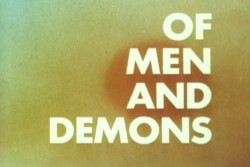 - Of Men and Demons, to me, has some of the finest artwork in any of the Hubley shorts. As I pointed out, once before, Tissa David told stories of reworking some animation by Art Babbitt, which was done on 12-15 levels and had to be reworked to come down to four levels. It was a monster of a puzzle for her and included reanimating some of the bits that were too complex to work properly in their reduced form. She then had to take over the sequence and complete the animation of it.
- Of Men and Demons, to me, has some of the finest artwork in any of the Hubley shorts. As I pointed out, once before, Tissa David told stories of reworking some animation by Art Babbitt, which was done on 12-15 levels and had to be reworked to come down to four levels. It was a monster of a puzzle for her and included reanimating some of the bits that were too complex to work properly in their reduced form. She then had to take over the sequence and complete the animation of it.
Here is a short piece that Tissa did of the little woman character seeding her front yard. There’s so much grace in every one of these drawings and enormous information in the walk, itself.
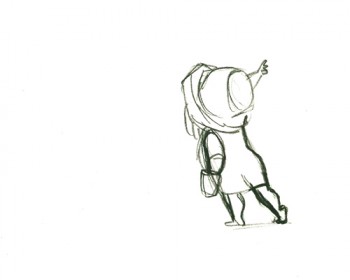 G47
G47(Click any image to enlarge to full animation sheet.)
.
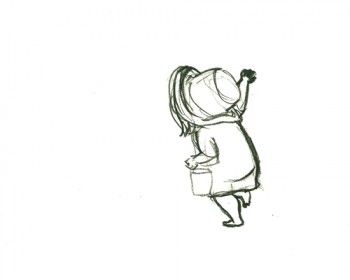 G49
G49.
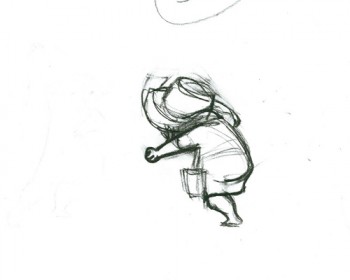 G51
G51.
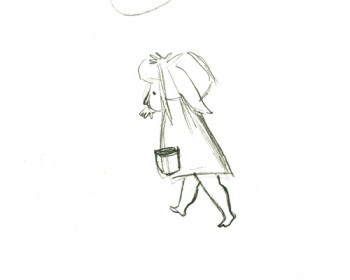 G53
G53.
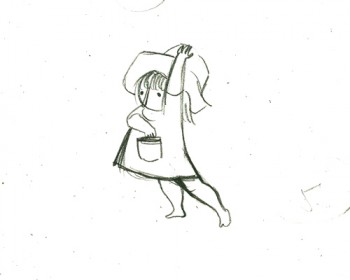 G55
G55.
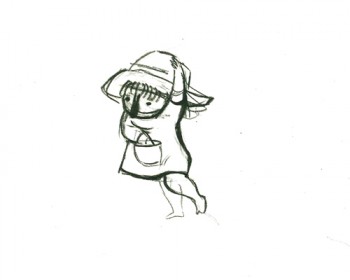 G57
G57.
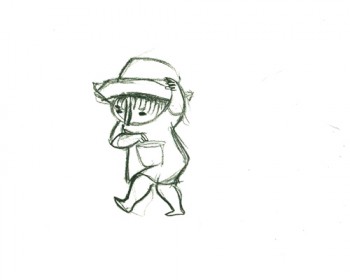 G59
G59.
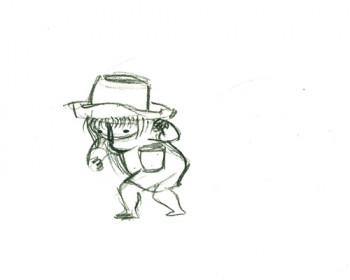 G61
G61.
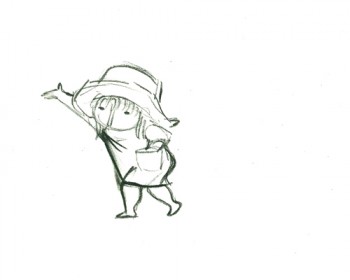 G63
G63.
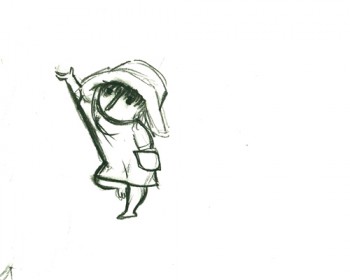 G65
G65.
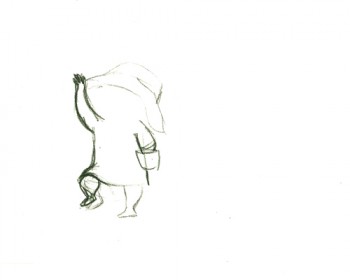 G67
G67.
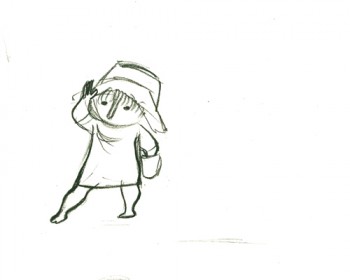 G69
G69
And here are the matching frame grabs from the film.
Seeding crops PT & Final Color
Click left side of the black bar to play.
Right side to watch single frame.
Animation Artifacts &Hubley &Story & Storyboards 09 Nov 2009 08:40 am
Doonesbury Start
- Today it’s back to the Doonesbury well. Tissa David was brought on to do the sequence where the kids put on the Christmas pageant. Through these materials we can see how the sequence takes shape even before the animator/director gets to do any character posing.
She, of course, was given the script as well as the original voice track for the sequence. These are the pages for the sequence:
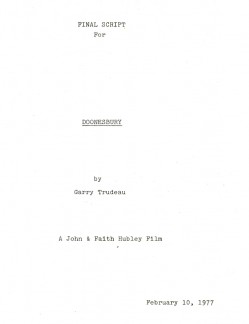 Cov
Cov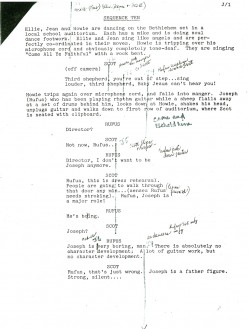 J1
J1(Click any image on this post to enlarge.)
.
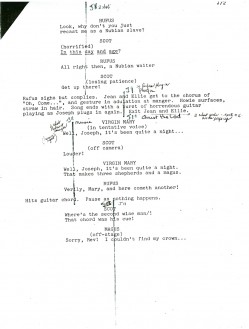 J2
J2 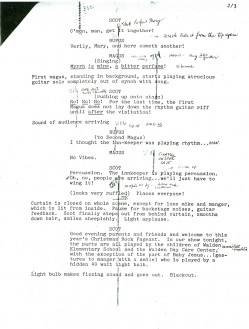 J3
J3Tissa also had a copy of the storyboard that John Hubley and Garry Trudeau did for the film. (Note that there’s no dialogue indicated. This is the way John and Faith worked. They’d memorized the track by the time they did the board.)
Tissa then took a bunch of specific frames from the board and blew them up. With these she decorated her walls all around her drawing table.
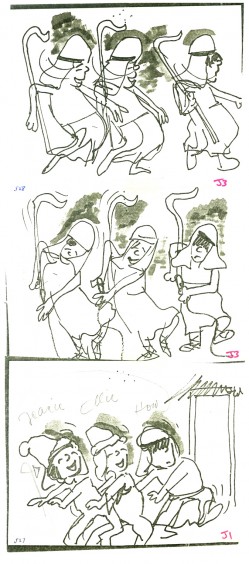
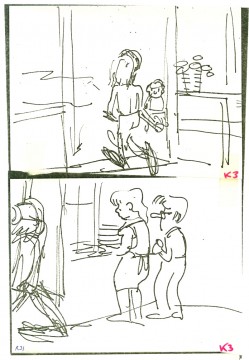
These drawings weren’t so much to act as models but as inspiration.
She plucked them from many different parts of the board even ones
that she did not work on.
.
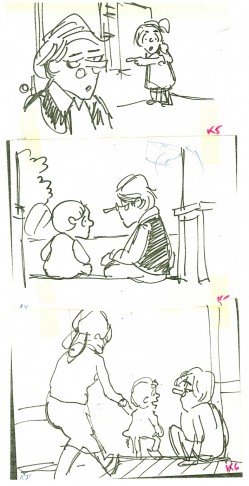
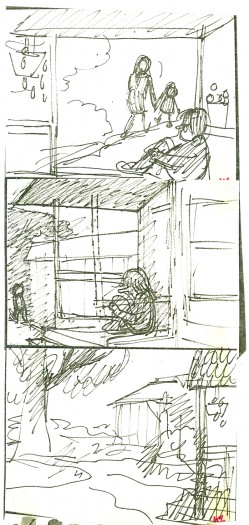
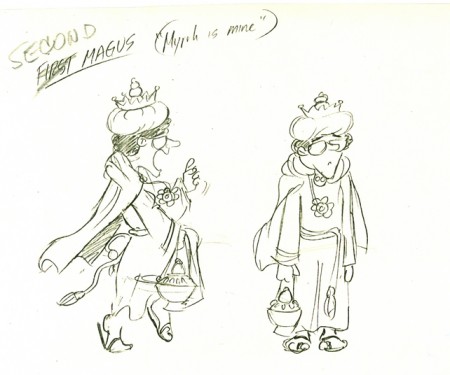
Here’s a drawing by Garry Trudeau that hung with the others.
Then, Tissa did her own board. She modified the scene arrangement and cutting. She always did this with John’s boards. He trusted her implicitly and gave her free reign to alter.
I only once saw them disagree about a scene – it was more about how it should be drawn. John won. he was the director.
This rough board Tissa did was only for herself. The drawing was quick and rough, and the images were small.
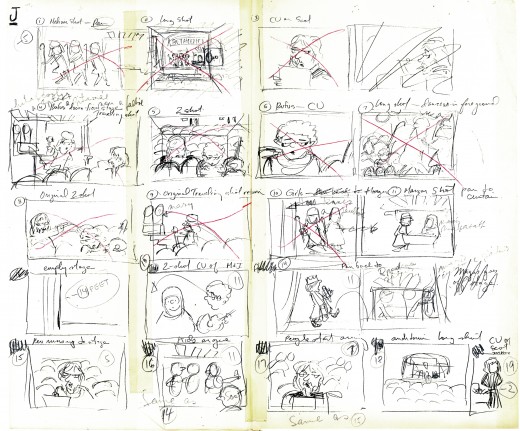
Finally, here are frame grabs from the actual sequence. Sorry, the colors are all over the place. The transfer is soft, and the colors never remain true.
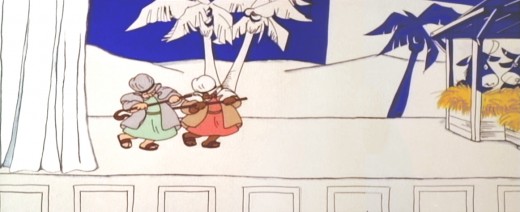 J1
J1
Hubley 15 Oct 2009 07:38 am
We Learn About the Telephone
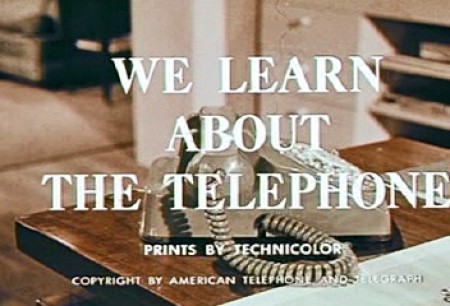 – In 1965, John Hubley directed animation inserts for an educational film for Jerry Fairbanks Productions and AT&T. It’s the story of the history of the telephone and how it works. The story, such that it is, tells about two kids visiting their uncle, an animator (actually, an actor playing an animator). He gives them an animated lecture on the story of the phone.
– In 1965, John Hubley directed animation inserts for an educational film for Jerry Fairbanks Productions and AT&T. It’s the story of the history of the telephone and how it works. The story, such that it is, tells about two kids visiting their uncle, an animator (actually, an actor playing an animator). He gives them an animated lecture on the story of the phone.
The film reminds me very much of another film done by the Hubley studio. UPKEEP was the history of the IBM repairman. We travel through history to see how the repairman has worked over the years. It’s a successful device that works in John’s hands.
The film is available to view on the Prelinger Film Archives. I’ve made some frame grabs to post to give an idea of the style. The characters seem to shift a bit stylistically from the humans at the beginning to those later at the circus. From Hubley to Jay Ward. This was a period where John Hubley was beginning to experiment with more expeditious styles for the jobs that came in. The more artful Maypo style was a bit complicated to pull off. The cels, here, are cel-painted traditionally. (I actually have a hard time believing the date on this film – 1965. It feels more like late 50′s.)
The backgrounds are all by John Hubley, and they remind me of those he would do for UPKEEP and PEOPLE PEOPLE PEOPLE. Lots of white space and soft images. The animation looks like it was done by several people. I recognize Emery Hawkins‘ style, and I also can see Bill Littlejohn in there.
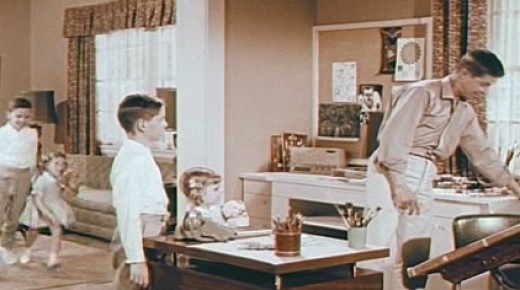 1
1The animator’s studio.
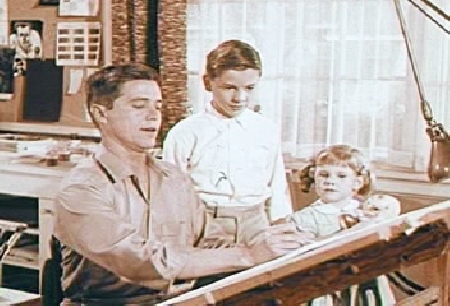 2
2
Kids are always fascinated when an animator draws.
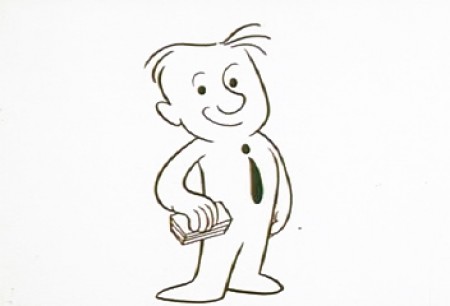 3
3
The character goes from this . . .
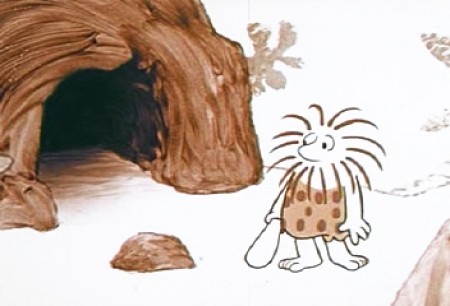 5
5
The caveman has to deliver a message.
![]()
This is the full length of his run, the pan wherein the character
runs from being a caveman to an Egyptian to a Roman.
Here’s the same BG broken into four parts:
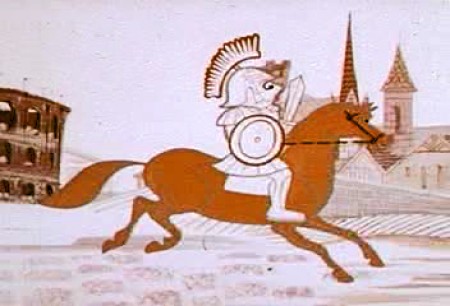 6
6
Once on horseback, man travels through
the middle ages to the pony express.
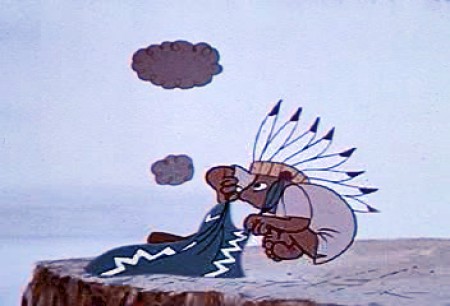 7
7
Man turns to smoke signals to communicate.
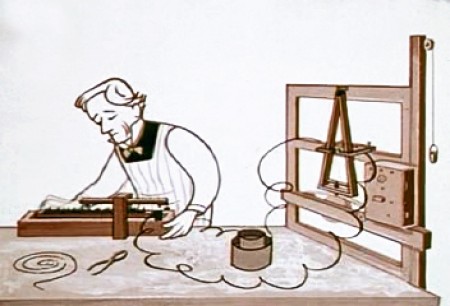 11
11
Morse invents the telegraph.
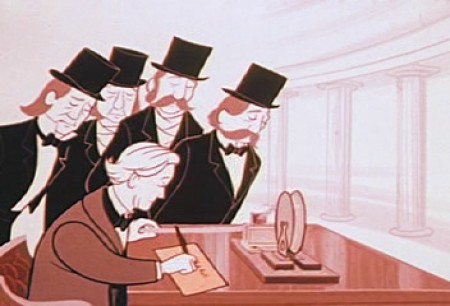 12
12
Alexander Graham Bell invents the telephone.
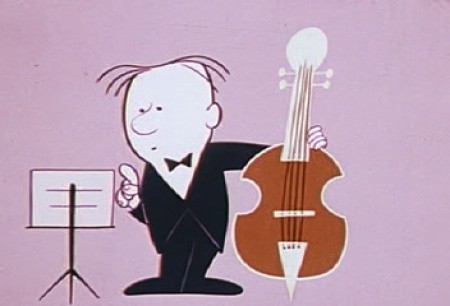 13
13
Now the animator explains how the telephone works
to two very interested children. .
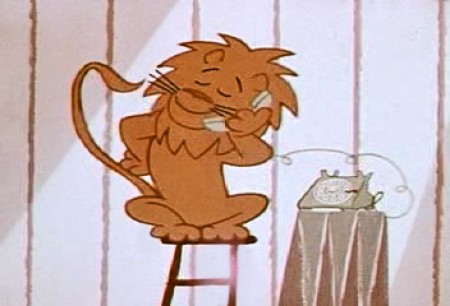 19
19
We get the fable about the lion who calls . . .
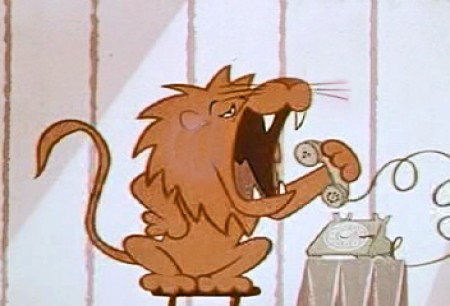 21
21
Though he shouts too loudly into the phone.
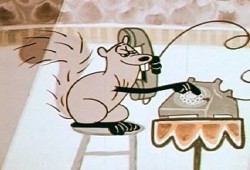 23
23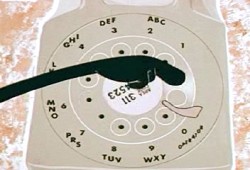 24
24
Then there’s the squirrel who can dial the phone . . .
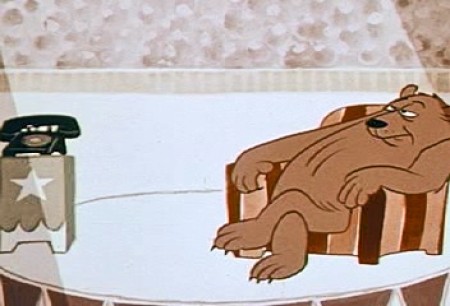 25
25
. . . and the bear who answers the phone too late.
 27
27
Then there’s the elephant who dials the wrong number.
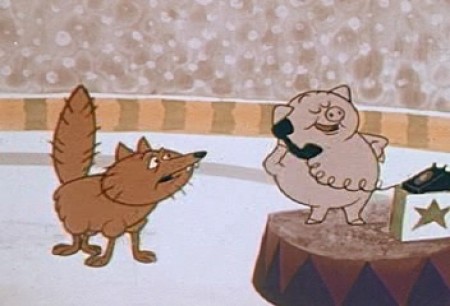 28
28
Finally there’s the pig who won’t get off the phone
so the fox can make an important call.
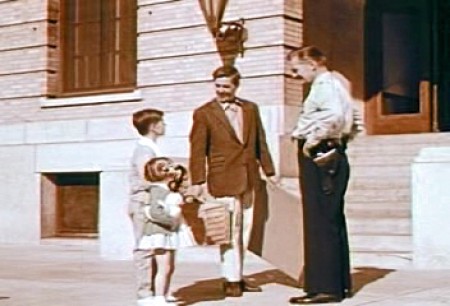 29
29
Next the animator takes the kids to the police station.
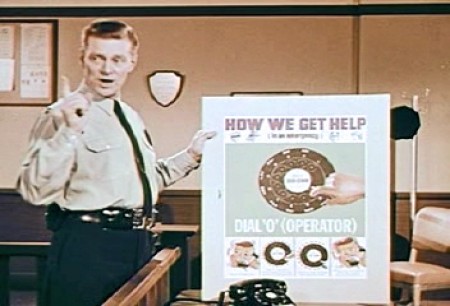 30
30
This way the cop can tell the kids how to make emergency calls.
Books &Hubley 26 Sep 2009 08:00 am
Zuckerkandl! book 2
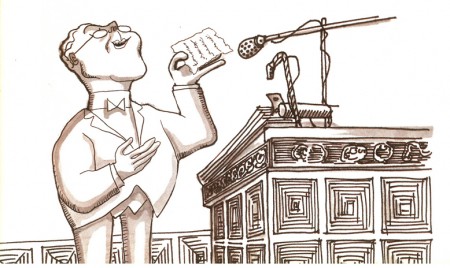 - I continue, today, with my posting of the book published from the setups of the John & Faith Hubley film Zuckerkandl!. This book was released by Grove Press in1968. It’s an adaptation of the comic lecture by Robert Maynard Hutchins espousing the philosophies of one, Alexander Zuckerkandl, M.D., Ph. D.
- I continue, today, with my posting of the book published from the setups of the John & Faith Hubley film Zuckerkandl!. This book was released by Grove Press in1968. It’s an adaptation of the comic lecture by Robert Maynard Hutchins espousing the philosophies of one, Alexander Zuckerkandl, M.D., Ph. D.
The artwork for the film was done wholly with Sharpie markers and Design markers. All of them bled through the Bristol paper for the backgrounds and the animation paper (cut out and glued to cels). All backgrounds were done by John Hubley. The animation was done by Vinnie Bell, Shamus Culhane, Tissa David, and Bill Littlejohn. The inking was by Faith Hubley, and coloring was by Nina Di Gangi & Sara Calogero.
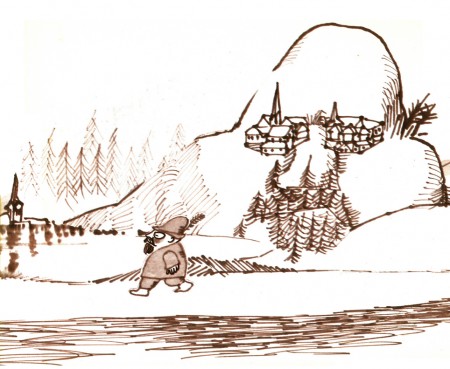 23
23(Click any image to enlarge.)
I have some more artwork for this film which I hope to put up soon.
Books &Hubley &Illustration 24 Sep 2009 07:57 am
Zuckerkandl! book 1
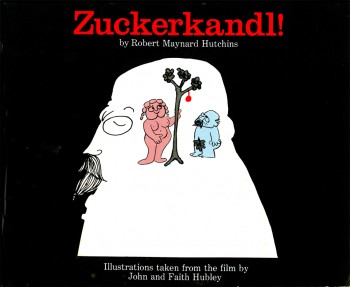 - Weeks back I posted a piece on the John & Faith Hubley film, Zuckerkandl!. There I posted some animation drawings, models and a several pages from the picture-book version of this film, which is a favorite of mine.
- Weeks back I posted a piece on the John & Faith Hubley film, Zuckerkandl!. There I posted some animation drawings, models and a several pages from the picture-book version of this film, which is a favorite of mine.
The story is an animated version of an annual lecture given by author, Robert Maynard Hutchins. The lecture is a parody of philosophical theories created by the author in the name of the fictitious Alexander Zuckerkandl, M.D., Ph.d.
A comment from Tom Shea at that post asked for a specific couple of setups (that I didn’t even approach), and I thought that I should, indeed, post all of the illustrations from the book (which were culled from the original art of the film.) Thus this post; here art those illustrations:
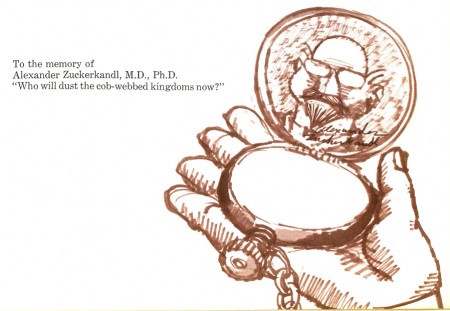
(Click any image to enlarge.) __
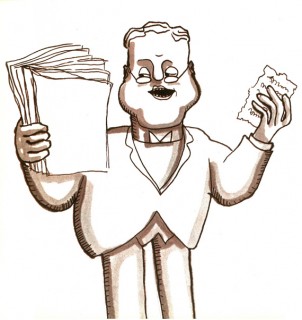 3
3
The remainder of this book will be posted Saturday.
Animation &Animation Artifacts &Hubley 03 Aug 2009 07:55 am
Hats & Fish
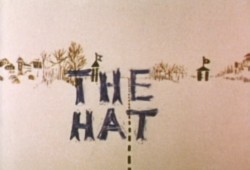 - Here are some drawings from the Hubley short, The Hat.
- Here are some drawings from the Hubley short, The Hat.
I first became aware of this short about the absurdity of border lines from a pre-PBS “educational TV” show on NY’s WNDT channel 13. Film critic Stanley Kaufman used to host a show called, “The Art of Film” in which he would have guests explaining their individual craft.
I can remember well a segment which featured composer, Elmer Bernstein, breaking down his music for The Magnificent 7. It was very informative and remains with me in memory to this day when I see the film.
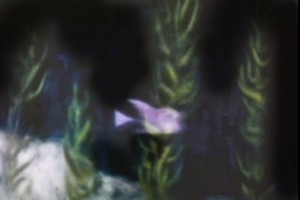 - John and Faith Hubley were on this show with drawings and storyboard and cels and Bgs from The Hat, then in production. I couldn’t have been more impressed and waited impatiently for about a year to see the film at the Beekman theater in NYC playing with Of Stars and Men.
- John and Faith Hubley were on this show with drawings and storyboard and cels and Bgs from The Hat, then in production. I couldn’t have been more impressed and waited impatiently for about a year to see the film at the Beekman theater in NYC playing with Of Stars and Men.
The style was one that John had been developing which had been successful for him. They would take the relatively clean animation drawings (done primarily here by Bill Littlejohn) and would paint them black. By that I mean, they would paint all the free space, outside the borders of the character, with black oil paint. (The oil paint didn’t stretch or buckle or shrink the paper. It just took forever to dry and destroyed the cells of the painters’ brains.)
The cameraman, Jack Buehre, would shoot the Background, then roll back the film and shoot the blackened characters as a double exposure. If there were more than one character it could mean several overlapping exposures.
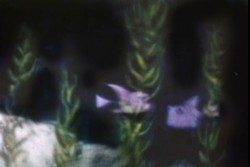
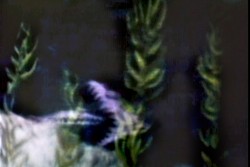
Here are examples of the animation in the final scene.
The exposure of the white drawings was shot at about 70%.
This allowed the characters to pick up some color from the dark violet
backgrounds. A ripple glass was also used over the drawings and bgs.
